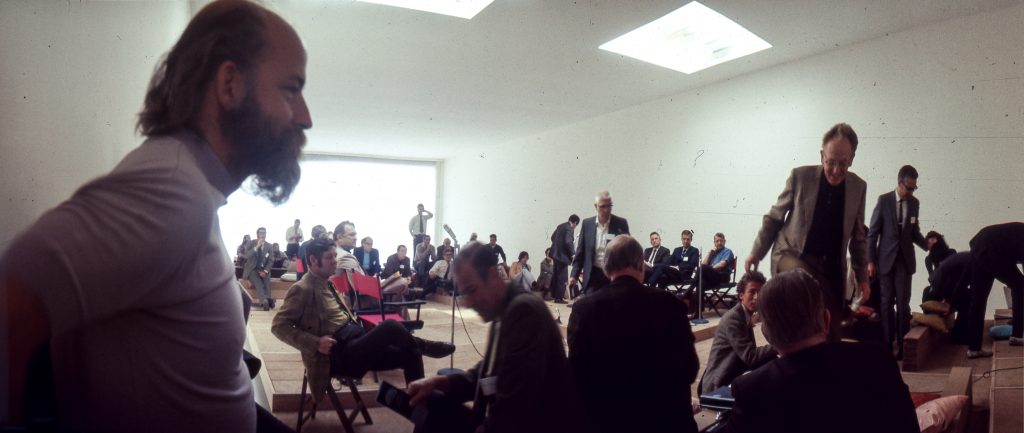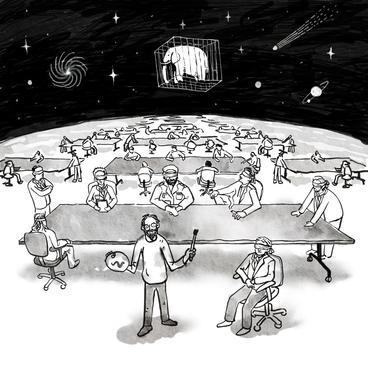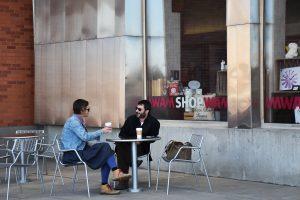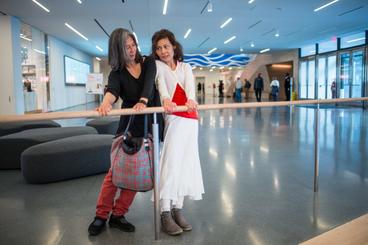Learn about the Second National Symposium on Habitability of Environments, hosted by WAM, here >>
One interesting thing about being an artist now is that everything is a possibility. Which means you start out of the state of total chaos, and you have to assume the responsibility for every single thing you do or do not do. - Robert Irwin, from the film Drugs and Beyond, Extension Media Center, UCLA for the National Institute of Mental Health, 1971. “Historians [are] looking for those consistencies, those overlaps, where artists are affected or where there is a consistency or a carry-on of an idea by one artist from another time or another generation, while the artist is always, in a sense, insisting on differences. Artists are essentially always looking for the discrepancies; so they, in a sense, are almost facing the opposite directions, seemingly dealing with the same subject but approached in different ways, because each of them is looking for something different—and, of course, they’re going to find it.” Interview with Robert Irwin by Frederick S. Wight. Oral History Collection, Art Oral Histories, UCLA Library, Center for Oral History Research, P31. 1975 (published 1977)
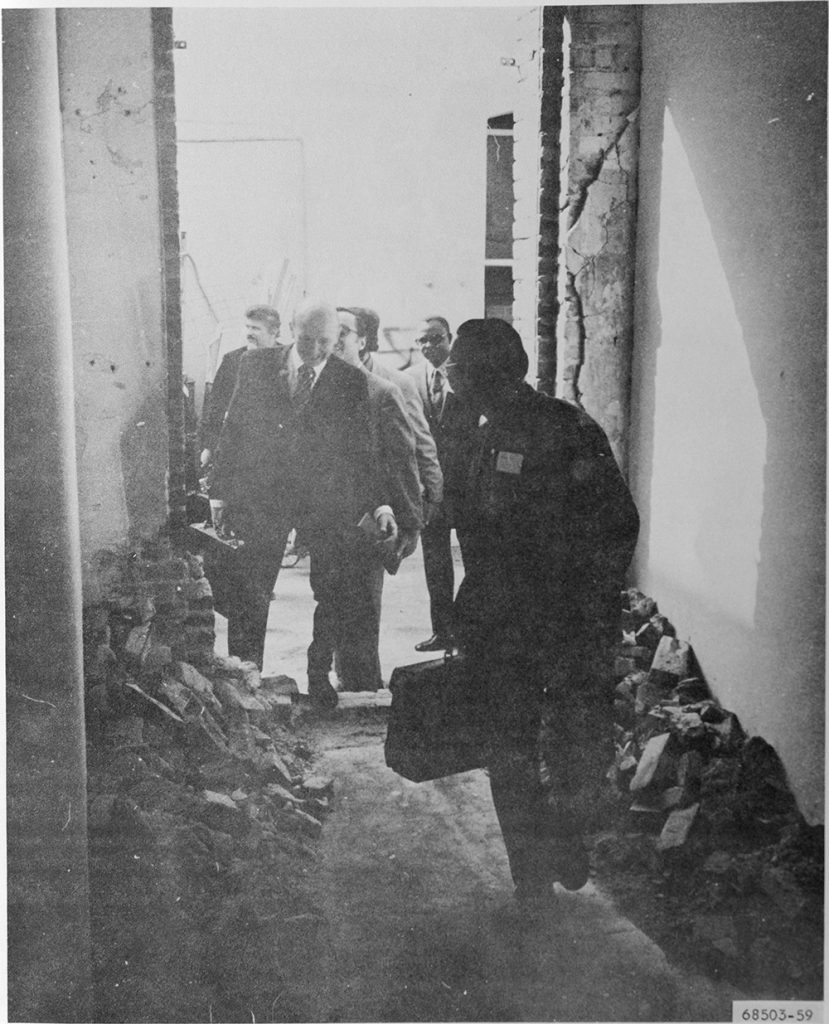
Introduction
A bus brings a group of people, most wearing suits, white shirts, and ties and carrying briefcases, from the downtown Intercontinental Hotel to a troubled oceanside neighborhood of hippies, surfers, homeless, and artists. They disembark by the beach and wander down a decrepit alley toward a recently made hole in a brick wall. They step through the hole, pass by a pile of rubble, and walk down a small corridor into a large, dimly lit room with slightly colored skylights in the ceiling, white columns at one end, two rows of facing elevated red canvas chairs in the center, and pillows spread on the floor. The time is the morning of May 11, 1970; the place is the studio of minimalist painter Robert Irwin in Venice, California; and the event is the First National Symposium on Habitability of Environments by NASA.
“Frequently mentioned but routinely under examined,”[2] this unlikely constellation of contexts, places, and characters was the brainchild of Irwin and his friend and collaborator Edward (Ed) Wortz, an experimental psychologist, then of the The Garrett Corporation.[3] Irwin redesigned his studio with the help of his neighbors artist Larry Bell and architect Frank Gehry. The facing rows of folding canvas chairs (Gehry’s idea) were for the panelists: the intentionally uncomfortable seating was meant to make it physically impossible to relax. The rest of the participants were invited to sit—or lie, as many eventually did—on the floor. The red chairs and Bell’s skylights contributed the only color to the space that otherwise was, on its first day, uniformly white.
On the second day of the symposium the participants followed the same route and arrived at the same studio. The white columns were gone. Where the columns had been there was now a large opening to the outside covered by a translucent paper: light and sounds of the street entered freely into the studio, which made it more difficult for the panelists and the audience to hear the speakers. The additional effort invested into perceiving the content established in their consciousness the interconnectedness of the event and its surroundings. This connection was further reinforced on the third day, when all separation between the symposium and the outside disappeared: the translucent paper had been torn down and the symposium became open to and accessible from the street, with occasional curious passers-by drifting in (“drunks and beach bums and young kids”[4]).
The participants ate their lunches on the curb outside. The afternoon discussion groups convened in Irwin’s second studio as well as in other artists’ studios nearby—those of Larry Bell, De Wain Valentine, and Ed Moses. One of those spaces, designed by Irwin, had uniformly lit, edgeless white walls that focused the discussants’ attention on their fellow participants: there was literally nothing else to fix the gaze on. Another room, one of Bell’s, had angled walls that made the acoustics so reverberant that speech became unintelligible: participants had to be near each other and speak softer. Still another of Bell’s rooms was small and painted black, with one bare incandescent bulb hanging in the center: it was considered by many to be overly oppressive. Most attendants found the discussion rooms untenable and eventually took charge of their working conditions, relocating their sessions to the nearby beach or the grass lawn.
I interviewed Robert Irwin at his home in San Diego, California, during two hour-long sessions on March 15 and 16, 2018. The conversation about events from nearly half a century ago inevitably wandered through many topics, and I edited the interview to its present form so that it would be directly relevant to the symposium. I kept the original language and style of Irwin’s speech intact wherever possible.
The interview was preceded by three days of researching in the archives of LACMA and the Getty Institute, in order to prepare for the Second National Symposium on Habitability of Environments. This explains the context for some of questions and comments in the interview.
- Boris Oicherman
Robert Irwin: The Art and Technology thing. All right. Just to put this in perspective: there were these people in New York[5] who were trying to find an area of interest that could organize artists to stop being so, as they put it, with their heads in the sand, because there are all these technologies and methods in the world that they should be conversing with. It came out here to the West Coast in the form of LACMA’s[6] curator Maurice Tuchman. Maurice Tuchman decided that he was gonna do the Art and Technology Program (A&T).[7] He asked all the leading artists to participate in it. And he asked me and I told him, “No.” He said, “Why?” And I said, “Because for me this hasn’t anything to do with technology. It has to do with a dialogue between artists and scientists. That would be really interesting.”
So he arranged a trip for me with the physicist Richard Feynman,[8] to take me around to all the things that are going on, the grand tour of the universe, IBM, all the big stuff that was going on in Southern California. Feynman came to the airplane, sat down next to me and started drawing portraits of people in the plane, and we started having a really interesting dialogue. We talked about how his father used to take him to the woods, and, say, a bird would go “Tweet, tweet, tweet.” And the father would say, “What is that?” And Richard would say, “I don’t know.” And his father would tell him it’s a robin. And Richard said, “Oh, great.” They did this for many birds, and then at the end of it the father said, “What do you know now?” Richard tried to tell him what a robin sounds like and that he can remember birds’ names. Then his father told him, “You don’t know anything. All you know is the name and a little sound. What actually is that?” Feynman told me that that was the beginning of his inquiry, as it were.
He asked me, "What does an artist do?" And I said, "What do you think an artist does?" And he told me about being a painter or a sculptor. I said, "You’re telling me names of birds. But you're not saying anything. You're not identifying anything." So, he and I started having a long dialogue.
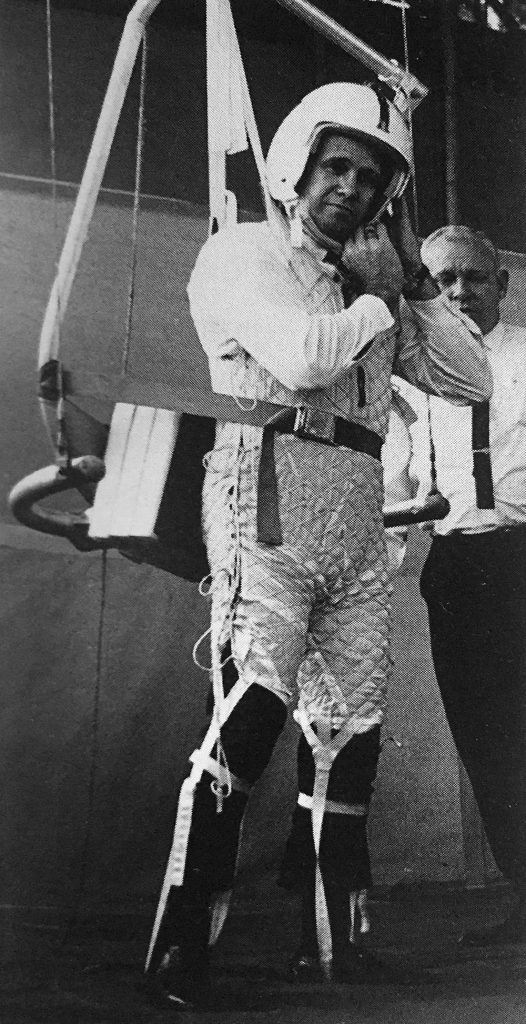
Then later I went to a place called Garrett Corporation. There was this guy who came with some wild equipment all over him. He was doing physiology for the walks on the moon. He was trying to figure out how much energy a person uses to go up a 20º slope on the moon. He sat down and said, “What does an artist do?” And I said, “That’s a big question. What do we do that has a real edge to it?” He and I started having a conversation, and it carried on for the rest of his life. This was Ed Wortz.[9] He was maybe one of if not the most important person in my life in the following twenty years. And maybe I was to him, because by the time we got through, he no longer worked at the Garrett. He’d become a therapist. He’d shrunk every artist in L.A. Everybody who had a problem went to Edward; he’d become indispensable. And my dialogue with him had become indispensable for me.
He was asked by NASA to do a symposium on habitability.[10] By that time he and I had been dialoguing for a while, so he gave me an invitation to do whatever I wanted to do. Give a paper, anything. I thought about it for a while, and thought, “No. One thing I don’t wanna do is a paper.” I thought about what happens in a symposium. What would I do? How would I communicate with these people? The symposium was on habitability and long-term space travel. And I thought: I’m gonna fuck with their habitability.
Normally, they come to town and they stay at the Intercontinental and they go down to the conference room and they sit around a table and they talk. I had a studio in Venice, California, not a bad space. I prepared that space to hold the symposium. I cleared the whole thing out and made it over.
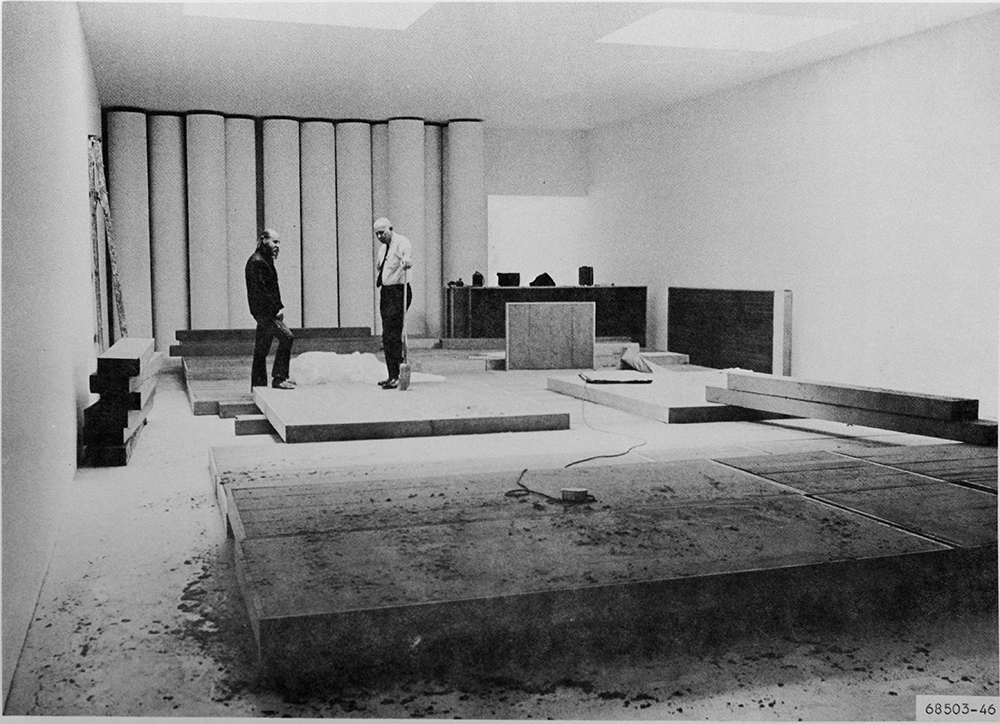
Then I had them brought over from the hotel. They were lost, they walked up an alley and there’s a hole in the wall that I just knocked down with a sledgehammer. They went in through it, and they were inside the space, which was a little bit like a capsule. There was no outdoor, no sense of where it was, no amenities, no outside light, no outside noise. I built a cardboard island, a stand for them to sit on so that the acoustics were good enough that they could carry on a normal conversation.
They were really fucked up. They were really nervous. This is not what they bargained for. This was not a comfortable space. There’s no daylight. There’s no sense of outdoors. You’re in a capsule. And so they persevered. I mean, they went ahead to do what they do, gave their papers, and everyone sat on this island. But during the first morning a lot of physical changes were made. They took off their jackets and they did the best they could do to accommodate this space, be in this space.
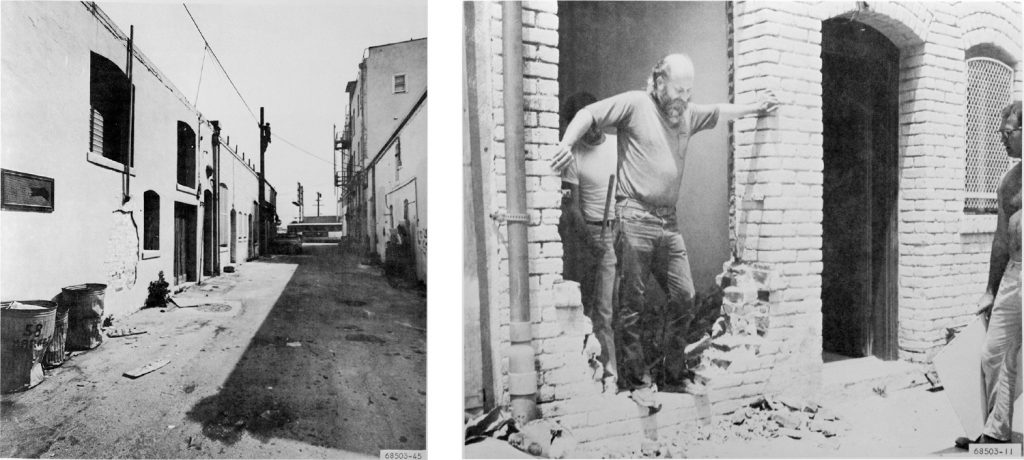
With other artists involved we prepared a lunch;[14] we tried to make it as crunchy as bittersweet, tactile as well as nutritious. In the afternoon, they broke up into smaller groups, each group having one component of the dialogue. We made rooms for them. We made a room that was just a little too small and we made a room that was just way too big. And we made a room that was too reverberant. And one which was too sound-dampened. Every room had a problem, a physical problem. And they persevered, because they’re professionals.

When they came the second day there was more light in the room. I had one wall made out of sonotubes[15] so that I could just swing it up.[16] And they were more relaxed that day. They changed. You could see their change of clothes and habits. People who started out the first day having trouble doing their papers, the second day they were in a much more accommodating mood. At the end of that day’s session I cut [the paper side wall] and we walked out through it; they all sat on the curb and began to intermix rather differently.

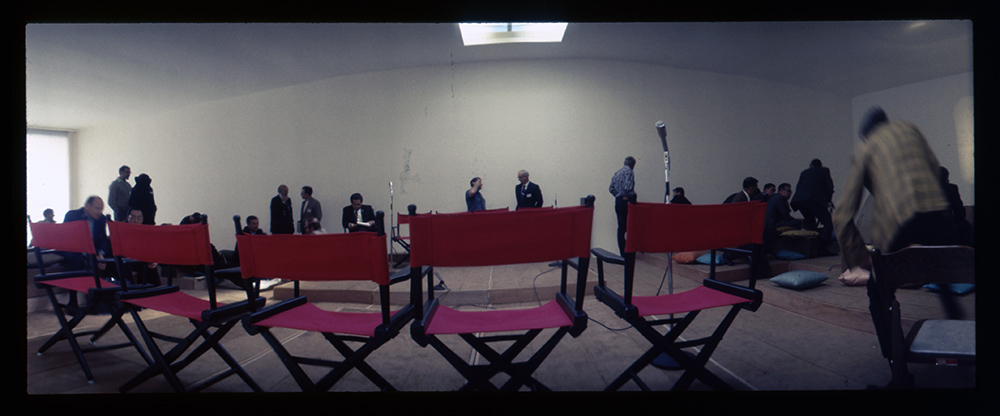
They were to go into those rooms, too big, too small, too reverberant, too dark, too light, and some said, “No. We're not gonna go in them. We’ll go out and sit on the beach and hold our thing.” Which, of course . . . The first day they were in suits and second day they dressed more casually and were amenable to go sit outside or on the beach. And because obviously these rooms had been too uncomfortable. I don’t know to what degree they acknowledged that.
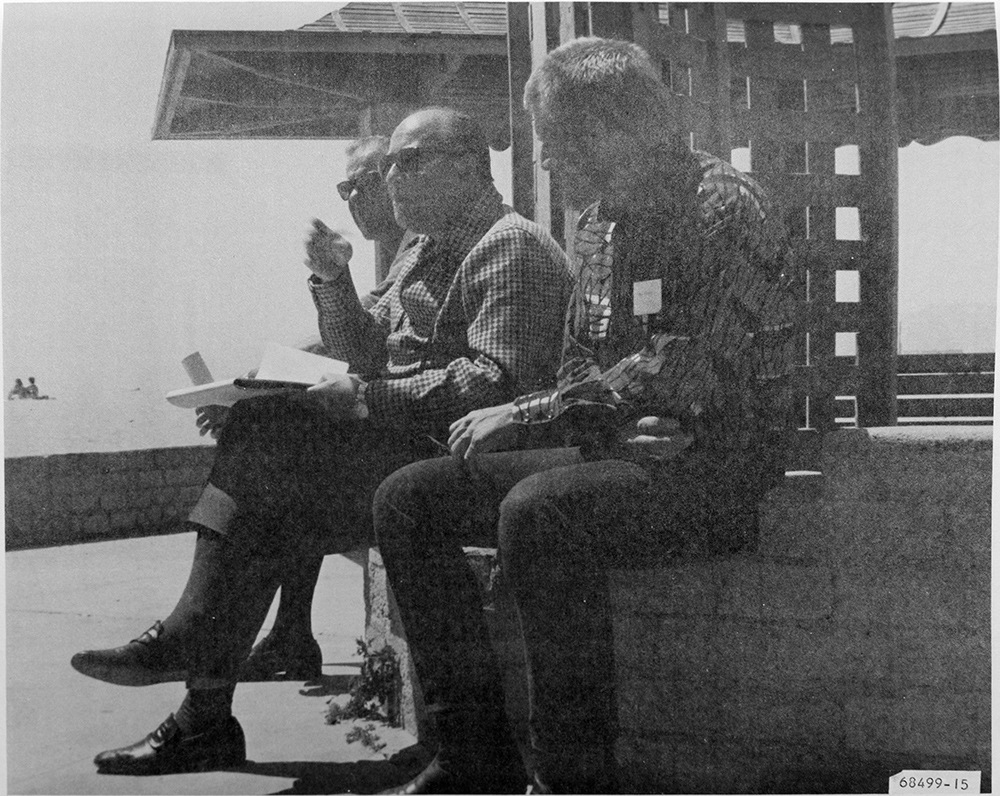
The environment had begun to change their habits and their comforts and their clothing and what have you. They were there to talk about being in a capsule, up for—what? Five years out in space? And they were having trouble being in a room on the second day ’cause there was something wrong with the room. And so began a real dialogue about habitability. By the fourth day, nobody wanted to leave, literally. They were like, “Something’s happening here.”
The symposium was, I think, a pretty big success. It didn’t answer any questions but it reframed the dialogue.

Boris Oicherman: How many people knew about what was going to happen?
RI: Nobody. No, Ed Wortz. Of course he knew, and it was dangerous for him.
BO: It was a guerrilla action in a sense.
RI: I guess so. I never thought of it in those terms. But I thought, you’re here to talk about what’s it gonna be like in a capsule? What’s it gonna feel like? How are you gonna entertain yourself? What are the amenities you need? Everything. Surface, sound, whether sound emanates or refracts or bounces around the room. These are what you’re gonna be experiencing. So it’s not a calculus. It’s a qualitative problem.
I didn’t know that it was gonna work as well as it did. It looked at moments that it was gonna explode in my face. Ed Wortz was willing to go along with the whole thing. Nobody else at NASA knew. Ed Wortz was the man who put his reputation on the line. He was willing to roll the dice with me. He knew something was going to go on. But he didn’t know what exactly.
Everybody wanted to sit around and talk, but they were not sure what they wanted to talk about. They hadn’t quite identified that what we had as a symposium was not about ideas but about how things feel. On the fourth day they stayed around beginning to talk about how these seemingly non-things affected their dialogue. It actually destroyed the symposium ’cause everybody gave up on their papers and started talking about, “What’s going on? Why are we feeling this way?” And some were identifying it, beginning to discuss the quality of being within a capsule for a long-term space travel. They actually started talking about what it felt like... how much they were affected by the physicality of the spaces they were in.
As an artist, I was more involved with those questions than they were. They couldn’t keep approaching the subject with the tools that they were using. You’re gonna have to employ an entirely new set of tools instead of intellectual propositions: physical, tactile. In other words, I had to make them be on the other side . . .
Nobody apparently had really got into the issues of what it was gonna be like in terms of feeling, in terms of time. You have a job and you’re holding on to it. Your sanity is actually connected to your job, and you persevere. But for how long? At what point does this thing begin to close in on you? And they were there. They called it habitability. So I gave them an exercise in habitability.
[Art] is not a teaching process. It’s not even a game of informing people. It’s a game of inquiry. It’s a way of looking at the world, which is what I changed for them. In which one examines the world and makes decisions, and how they have a meaning of their own, and what that meaning is. How we absorb it. How we act on it. How we function. How it affects us. How it makes, redefines what it's like to be in this part of the world, in this house.
You start out with [Jacques-Louis] David[18] doing incredibly beautiful painting and, in less than one hundred years, you arrive at [Kazimir] Malevich.[19] Malevich did the painting that he did, looked at it and said, “My God, everything we know is gone. It’s a desert.” He said, “Ah, yes. But it’s a desert of pure feeling.” You put those two together and, in the history of the nineteenth century, that’s exactly what art was doing. They did what I did in that symposium in a way: took away staples that disciplines are based on. What I had done with NASA was done to art in the nineteenth century.
Responsibility now becomes how and what way do we organize it as a discipline, as a way of knowing. That’s a big problem for me.
BO: Do you know why there is so little material about the symposium left in the LACMA archive?
RI: Because the symposium was done in the science world. LACMA never did a show about it. They never used the material. They did a show of the winking, blinking things that everybody did. The “art and science.” Nobody was interested at all. I think there’s been curiosity, but there’s never been any real interest in what happened there.
I think the problem [of cross-disciplinary work] is still a problem. It hasn’t been solved. Cross disciplining is the ambition of a lot of people in academia and has very seldom ever been pulled off. I’m just weighing right now in my mind what it would take for you to be able to do that.[20]
BO: How would you imagine a show about the symposium?
RI: I would say that it should have the character of the symposium. I mean, if you come to a museum and it looks like a museum and it acts like a museum . . . You have to ask: What kind of space do we have here? How do you come to it? Where do you come from? What distance do you have to walk? Where do you park your car? What time of the year is it? What are the expectations?
And how do you deal with those expectations and not give them what they think they’re gonna see. You’re gonna give them something entirely different. Do you have a space that has the flexibility? Most museums are pretty given, so you’re better off in a warehouse so you can move it around a bit more.
BO: So, in a way, what you’re saying, I should make the museum less of a museum to make this work.
RI: Well, I think, yeah. First of all is, when people come to a museum, they’re already presupposed, predisposed to see certain things. And to see them in a very particular way. The first thing you have to do is break that habit.
I was more prepared to deal with their problem than they were. They had a methodology, but they were dealing with a problem that was completely antithetical to their methodology. So I made them do something they don’t normally do, which is to act as a feeling human being in which feelings are tantamount to ideas, and there is not a war between them. Everything, the only thing I’ve done, is I’m an artist.
Everything I did is a part of figuring out what an artist is. What is the game we play?
BO: Now, I am an artist who works in a museum. I’m trying to answer this question: what am I doing in a museum as an artist?
RI: That’s a good question. You probably should get the fuck out of there, if you’re gonna be an artist. How is art connected to a museum? Is a museum critical to it? Is it actually the way art should be shown or understood? Or is it a distraction? It certainly, historically, has a very well defined role. But is it a role that is relevant right now?
BO: Maybe we don’t have the resources of NASA, but...
RI: It’s not so much a matter of resources but that all these people were critical to the dialogue, because they were the ones who were going to do it. It wasn’t a symposium for a show. It was a serious business for them. I don’t know that anybody could ever put anything in that area together. NASA had to. I don’t know how you’d ever duplicate that.
BO: If you would do it, how would you approach it?
RI: That’s a real problem. Why has it [the interdisciplinary dialogue] failed so many times? It’s failed hundreds of times. It’s such a good idea, the idea of interdisciplinary dialogue. That’s a very desirable idea and it’s an idea that everyone appreciates. Despite that it’s very hard to find situations where it succeeded.
Why hasn’t it worked? The first thing I would think is whether there was fruition. People didn’t really get together and were not really an interested group who really wanted to know what other people are thinking… The dialogue has to be a real dialogue. That’s not an easy thing to create. I guess in this case [of the symposium], these people all came together because of a big project—a historical project was the reward. All the people there wanted to be a part of it. That was the moment, you know?
The guy who’s maybe somebody you should speak with is Elon Musk. That’s his calling card. The guy is pretty interesting and is willing to roll the dice. He’s a gambler, he’s willing to play the game. Man, you know, he just sent that fucking rocket up? He did it. I was really impressed. Not only he shot it out, but he brought it back down better than NASA did. He profited from all their mistakes. I would like to meet that guy. I would like to spend a little time with him. I’d like to talk with that guy. I mean if you put the thing together I’d come to it and I would participate. To be able to sit down with him would be a treat.
I’m just playing now, I mean, why would people come to your thing? That’s one reason right there.
They were all in suits, and they went through the door that was just a hole knocked in the wall. Why? Because they really wanted to be there. They were really interested, so they were trapped by their own curiosity. They were in a position for me to take advantage of that. In many situations, if I had done what I did, they would have just said, “Fuck it. I’m going back.”
They wanted to be there badly because what brought them there had nothing to do with me. It had to do with their real interest in what they were to discuss. They tolerated the interference, which turned out to be a major part of their discussion because it was the one thing that nobody had thought about. But actually it was the nature of the symposium, which was habitability. The question of how do you send somebody out for a year or two or whatever and bring them back sane?
The trip to the universe. It was a totally intriguing and beautiful problem, but it was not their area of expertise, what it was going to feel like. We can do it technically, we can get the guy up there, but how are we going to bring this guy back sane, not completely destroyed by the experience that’s probably overwhelming and daunting. He’ll grit his teeth, but if you’re really going to go on larger journeys you have to take into account whether you create enough habitability, enough sense of place—besides just gritting teeth.
Whether I’m right or wrong, in my mind I got involved in a really great question of what it means to be an artist right now and in what way art is going to manifest itself.
BO: How did this question change after the symposium?
RI: First of all, whether or not I even knew that exactly, that was worth the ticket.
Everything else paled, whether I was making money, not making money, whether I was showing, not showing. I had the best game in town. This game was wide open. The questions are real and ripe and exciting. There were a lot of winking, blinking alternatives that you can make money off, can be at the Met. But why would you do these things when you feel like you’re actually having a real dialogue with the history of the discipline?
A lot of things just happened [in the symposium] that made that whole thing work. You might do it again and everybody could say, “What the fuck am I doing here? I’m going home.” They wanted to be there. For them it was being at a symposium for a subject that they’re really committed to. They were willing to go through that hole in the wall.
They didn’t come there for what I did. They were affected by what I did. They came there because they were really interested in the subject. It’s a rare thing. It had nothing to do with what I did at all. They came there for a reason and a purpose and each of them had a level of dedication that brought them there.
They tolerated this thing in the beginning—and then became aware that, essentially, this was an exercise in the problem they’d come to solve.
[1] Source: Edward Wortz, First National Symposium on Habitability, Volume IV: What Happened in Part. Photographer unknown.
[2] James Thomas’s characterization of the Symposium in The Aesthetics of Habitability: Edward C. Wortz, NASA, and the Art of Light and Space, 1966–1973, PhD thesis, Stanford University, California, 2014.
[3] An aerospace engineering company contracted by NASA for the development of inhabitable space capsules, characterized by the Time Magazine as the “...U.S.'s foremost specialist in keeping men alive in the yonder beyond their familiar surroundings.” (Time Magazine, Built on Thin Air, November 16, 1962).
[4] Interview with Robert Irwin in Lawrence Weschler, Seeing Is Forgetting the Name of the Thing One Sees (Berkeley: University of California Press, 1982).
[5] Irwin refers to Experiments in Art and Technology (EAT), a program founded by Billy Klüver, Fred Waldhauer, Robert Rauschenberg and Robert Whitman in New York in 1967.
[6] Los Angeles County Museum of Art
[7] Maurice Tuchman, A Report on Art and Technology Program of the Los Angeles County Museum of Art, LACMA, 1969–71.
[8] Richard Phillips Feynman (1918–1988), Nobel laureate in physics in 1965.
[9] Edward Charles Wortz (1930–2004), at the time a research scientist at the Garrett Corporation working on psychology of space travel.
[10] Habitability is the study of habitable environments. In this case, the term refers to the design of habitable environments in outer space.
[11] Source: Edward Wortz, First National Symposium on Habitability, Volume IV: What Happened in Part. Photographer unknown.
[12] Source: Edward Wortz, First National Symposium on Habitability, Volume IV: What Happened in Part. Photographer unknown.
[13] All color images are from Larry Bell Studio archive. Bell’s color images of the symposium were discovered and first published by Matthew T. Simms in Robert Irwin: A Conditional Art, Yale University Press, 2016
[14] Larry Bell and Frank Gehry worked with Irwin on the design of the symposium.
[15] Lightweight tubes made of cardboard
[16] The side wall of the studio behind the sonotubes was covered with translucent paper that let light and sound in.
[17] Source: Edward Wortz, First National Symposium on Habitability, Volume IV: What Happened in Part. Photographer unknown.
[18] Jacques-Louis David (1748 – 1825), French painter
[19] Kazimir Malevich (1879-1935), Russian painter
[20] Irwin refers to organising the Second National Symposium on Habitability.
